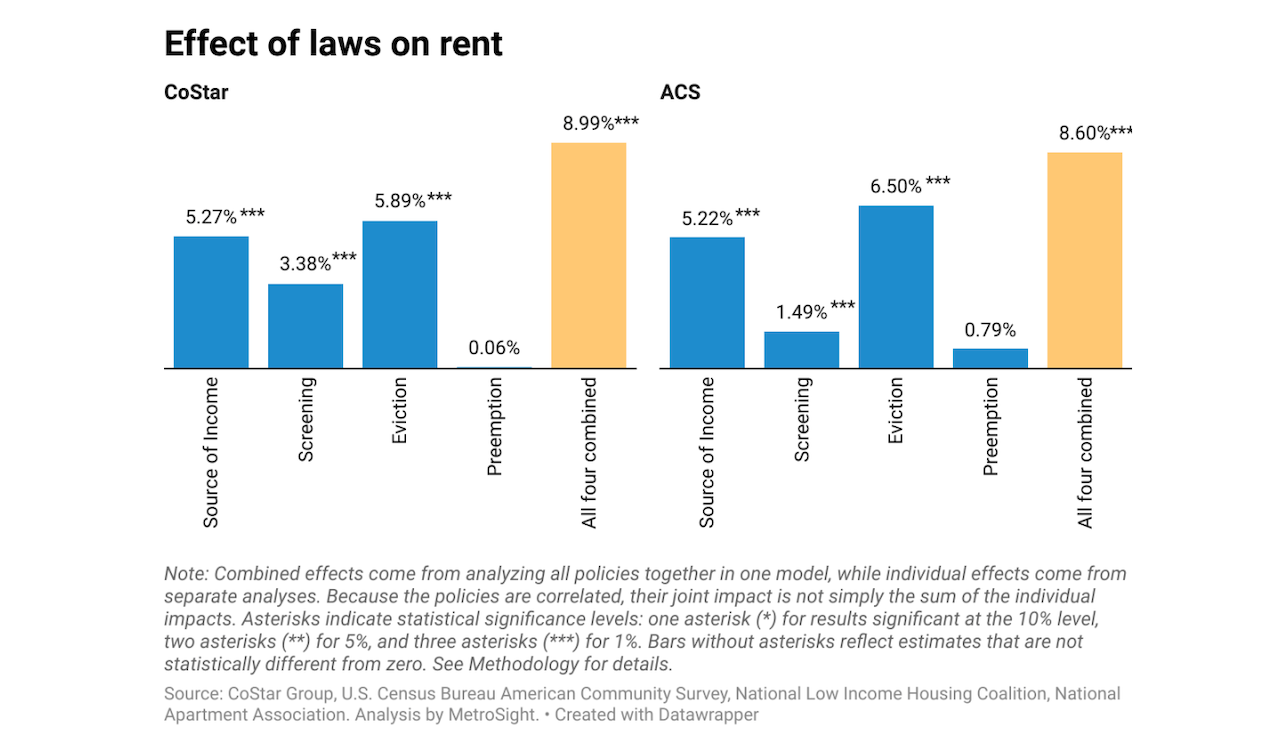Policy
Well-Intended Laws, Higher Rents: A Data-Driven Look
A MetroSight study finds that common tenant protection laws—on evictions, vouchers, and screening—raise rents by 3% to 6%, with the steepest impacts hitting low-income renters.

For decades, lawmakers crafted layer upon layer of tenant protections—measures designed to shield renters from exploitation, neglect, and arbitrary treatment by people who were often regarded as unscrupulous landlords.
However, what if the sheer weight of these protections now bears down on the future, morphing from shield to stumbling block, and harming the very people the measures are meant to help?
This riddle forms the core of MetroSight economists Issi Romem and Daniel Shoag’s latest study, which mathematically unpacks how well-intentioned regulations can, at times, go awry, straining the affordability and access they were designed to defend.
Romem and Shoag quantify the increase in rents resulting from these regulations, with the impact primarily falling on lower-income renters.
Apartment developers and homebuilders often find themselves entangled in regulatory hurdles that increase the cost of housing construction.
In response to the affordability crisis that surged during the Covid-19 pandemic, cities and states have begun—sometimes haltingly—to lower regulatory barriers. The study reinforces the importance of continuing these efforts.
Thoughtful regulation should safeguard renters from harm while avoiding undue burdens on multifamily operators that drive up costs and ultimately lead to higher rents,” the study says.
Building on Past Lessons
This latest study builds upon the "Behind the High Cost of Rent" report from earlier in 2025, which analyzed operational data from thousands of multifamily properties.
The initial MetroSight analysis found that regulations raised costs for apartment operators, particularly through increased vacancy losses, prolonged eviction processes, and costly upgrades after resident screening rules changed.
These findings set the stage for the follow-up, which shifts the focus from landlord expenses to the actual impact on rent levels, drawing on market data from CoStar and household data from the Census.
Regulation, Costs, and Rent
In their new study, the economists examined the effect of four kinds of regulation—source-of-income protections, eviction restrictions, resident screening laws, and state law preemption—across hundreds of metropolitan areas:

- Source-of-income laws (designed to support voucher holders) raised rents between 5.2% and 5.3%, an increase of about $876 to $1,104 per unit annually.
- Eviction regulations (such as just-cause requirements) increased rents by 5.9% to 6.3%, up to $1,224 per unit each year.
- Screening restriction laws (limiting the use of criminal or credit histories) lifted rents by 1.5% to 3.4%, or $252–$708 per unit per year.
- State preemption laws showed no significant statistical impact on rents. States like Texas and Florida have passed laws both easing the zoning process and preventing local governments from instituting rent control or stricter tenant protections.
Passing the Burden
The findings reveal that higher costs hit low-income renters and owners of small multifamily buildings—especially those with just two to four units—most acutely.
These properties, typically serving the least affluent tenants and managed by owners with limited financial capacity, are less able to absorb new expenses. As a result, almost all regulatory costs are passed onto tenants in the form of higher rents.
Broader Implications
Romem and Shoag’s research highlights a classic economic lesson: regulations intended to protect renters can unintentionally make housing less affordable.
With nearly half of U.S. renters spending more than 30% of their income on housing, policymakers face a difficult balancing act. The study encourages leaders to revisit regulatory measures, prioritizing supply growth and affordability rather than adding costly new protections.
As the housing debate evolves, MetroSight’s work serves as a reference point for understanding the complex forces driving rent increases and for creating more effective, inclusive housing policies.
MORE IN Policy
Arkansas ADU Law Sets Fast-Approaching Housing Deadline
Arkansas’s bold new housing law gives cities until January 1 to legalize accessory dwelling units statewide. The move could reshape how local zoning and housing affordability intersect across one of America’s fastest-growing regions.
Dallas Rewrites Its Zoning Legacy to Fix Housing Shortage
After decades of single-family dominance, Dallas is embracing density again. A landmark ordinance revives small-scale housing once zoned out of existence — and signals a turning point for Texas growth policy.
Arizona’s New Water Framework Revives Housing Prospects
After a yearlong construction freeze, Arizona finally has a path forward. A new water framework could unlock 60,000 homes — and redefine how growth happens in the desert.
